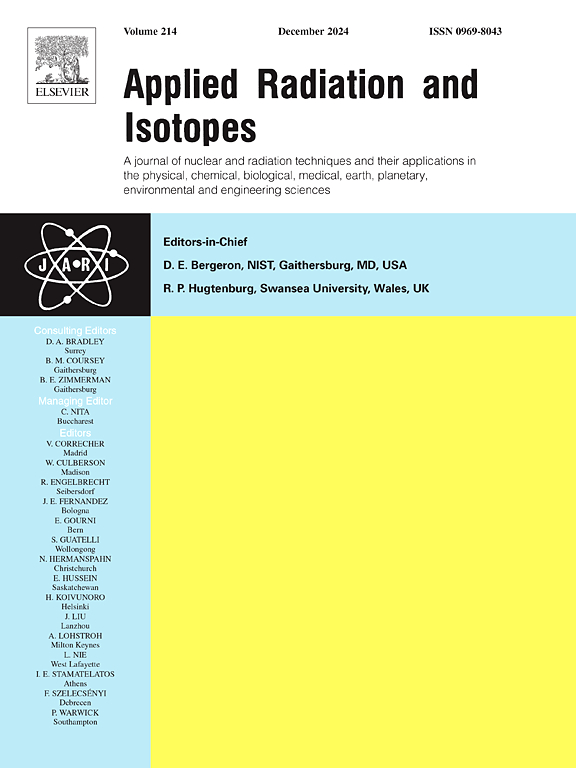Advancements in neutron dosimetry: A comprehensive FLUKA simulation of PLASTIC scintillator response across multiple irradiation geometries
IF 1.6
3区 工程技术
Q3 CHEMISTRY, INORGANIC & NUCLEAR
引用次数: 0
Abstract
The present study offers a new computational tool for characterizing neutron particle spectrums and calculating dose, which may be helpful for use in medical imaging, nuclear physics, and industrial process applications. Using a state-of-the-art detector response matrix, this study explores the complex response behavior of a PLASTIC scintillator to neutron interactions. Scintillation detectors have unique interaction properties, and the investigation relies on this for a detailed analysis of their performance. FLUKA simulation code and the FLAIR interface are used to calculate the neutron energy deposited on the scintillator for a full range of neutron energies 0.001–10 MeV and three types of irradiation; Axial, non-axial, and Radial. This very extensive sim shows the subtleties of the response of the scintillator material for a slightly off-center hit, where the neighbor hits over time would affect the overall measurement depending on the orientation in which the scintillator is mounted and whether it can detect it. The results showcase the effectiveness of the detector in differentiating between different energies of neutrons and the decrease in energy resolution with respect to neutron energy, a key aspect of neutron detector design and applications. Additionally, the study showcases the breadth of applicability of Monte Carlo simulations to create a versatile detector response matrix and function to strengthen fundamental neutron interaction knowledge. This key piece of groundwork lays the foundation for future work on the behavior of other types of particles and enables new applications in accurate neutron detection and measurement.
中子剂量学的进展:跨多种辐照几何形状的塑料闪烁体响应的综合FLUKA模拟
本研究为中子粒子光谱表征和剂量计算提供了一种新的计算工具,可用于医学成像、核物理和工业过程应用。利用最先进的探测器响应矩阵,本研究探讨了塑料闪烁体对中子相互作用的复杂响应行为。闪烁探测器具有独特的相互作用特性,研究依赖于此来详细分析其性能。利用FLUKA仿真代码和FLAIR界面计算了在0.001 ~ 10 MeV全范围和三种辐照方式下,闪烁体上沉积的中子能量;轴向,非轴向和径向。这个非常广泛的模拟显示了闪烁体材料对稍微偏离中心的撞击的微妙反应,随着时间的推移,邻近的撞击会影响整体测量,这取决于闪烁体安装的方向以及它是否可以检测到它。结果表明探测器在区分中子的不同能量方面的有效性,以及相对于中子能量的能量分辨率的降低,这是中子探测器设计和应用的一个关键方面。此外,该研究展示了蒙特卡罗模拟在创建多功能探测器响应矩阵和函数方面的广泛适用性,以加强基本的中子相互作用知识。这一关键的基础工作为未来研究其他类型粒子的行为奠定了基础,并使精确中子探测和测量的新应用成为可能。
本文章由计算机程序翻译,如有差异,请以英文原文为准。
求助全文
约1分钟内获得全文
求助全文
来源期刊

Applied Radiation and Isotopes
工程技术-核科学技术
CiteScore
3.00
自引率
12.50%
发文量
406
审稿时长
13.5 months
期刊介绍:
Applied Radiation and Isotopes provides a high quality medium for the publication of substantial, original and scientific and technological papers on the development and peaceful application of nuclear, radiation and radionuclide techniques in chemistry, physics, biochemistry, biology, medicine, security, engineering and in the earth, planetary and environmental sciences, all including dosimetry. Nuclear techniques are defined in the broadest sense and both experimental and theoretical papers are welcome. They include the development and use of α- and β-particles, X-rays and γ-rays, neutrons and other nuclear particles and radiations from all sources, including radionuclides, synchrotron sources, cyclotrons and reactors and from the natural environment.
The journal aims to publish papers with significance to an international audience, containing substantial novelty and scientific impact. The Editors reserve the rights to reject, with or without external review, papers that do not meet these criteria.
Papers dealing with radiation processing, i.e., where radiation is used to bring about a biological, chemical or physical change in a material, should be directed to our sister journal Radiation Physics and Chemistry.
 求助内容:
求助内容: 应助结果提醒方式:
应助结果提醒方式:


